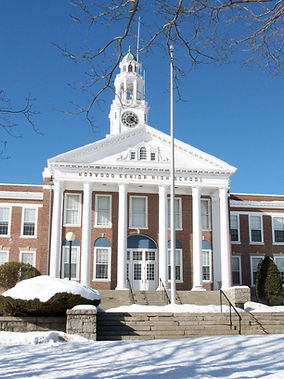Historic School Buildings
The Historic School Building Initiative began in 1997 in response to the Massachusetts School Building Assistance Program (SBA) that unambiguously favored and funded new construction over renovation. Although the SBA had been codified by the Massachusetts General Laws (M.G.L.) in 1948, communities were galvanized into action by the mid-1990s in order to subdue the negative effects of sprawl on older downtowns and neighborhoods and ensure the preservation of their historic schools and public open spaces. To aid those communities, Preservation Massachusetts (PM) assembled a group of volunteers and professionals to determine the scope of the problem, identify the issues, and research and promote best practice strategies learned from successful renovations of older school buildings.
In addition to providing assistance in the field to community activists and local preservation commission members, PM wrote The Historic School Building Report., to complement local school facilities planning and review processes by providing background information on school facility policies and standards as well as examples of how Massachusetts’s communities have created outstanding educational spaces through the reuse of their older schools.
The Historic School Building Report was prepared to bring about greater awareness of the benefits of using existing buildings and the challenges communities face as they renovate schools. As the various case studies included in the report demonstrate, existing buildings can not only house extraordinary educational spaces, but they also provide a link to a community’s heritage and protect open space by encouraging rehabilitation over sprawl and new development.
Context: A National Challenge
As we began to research this issue in 1997, we learned that the issue was national. In addition to Massachusetts, states like Maine, Maryland, Vermont, Pennsylvania, North Carolina, and Georgia sought policy and regulatory changes to stop the abandonment and destruction of their older school buildings. Furthermore, in November 2000, the National Trust for Historic Preservation named Historic Schools to its national list of Most Endangered Historic Resources and released its report Historic Neighborhood Schools in the Age of Sprawl: Why Johnny Can’t Walk to School, further highlighting the national scope of threatened school buildings.
Since 1997: Changes - Good and Bad...
The attention focused on the precarious position of neighborhood and historic schools in Massachusetts resulted in positive change. In July 2000, Massachusetts enacted the most far-reaching changes to the SBA since its creation in 1948. A new state law mandates that school construction funding must be guided by principles grounded in the preservation of open space, thoughtful community development, and project flexibility (M.G.L. c. 70B). The Massachusetts Department of Education also adopted new regulations pertaining to the SBA, which emphasizes the reuse of existing structures, alternatives to new construction, sound planning practices, and adequate building maintenance (603 CMR 38.00). The new regulations not only benefit older schools, but also help communities make informed decisions on their school building needs and better manage school construction projects. The first round of funding for school construction and renovation projects under the new laws and regulations was in July 2001.
Unfortunately the regulations that incorporated new positive changes were altered in 2006 and the current MSBA guidelines make it very difficult to restore and reuse historic school buildings. The 2018 listing of Arlington High School on our Massachusetts Most Endangered Historic Resources List made this clear and efforts to once again advocate on behalf of historic schools as viable options for serving the evolving and continued needs of our students.

